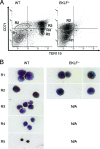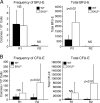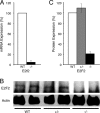Failure of terminal erythroid differentiation in EKLF-deficient mice is associated with cell cycle perturbation and reduced expression of E2F2
- PMID: 18852285
- PMCID: PMC2593440
- DOI: 10.1128/MCB.01087-08
Failure of terminal erythroid differentiation in EKLF-deficient mice is associated with cell cycle perturbation and reduced expression of E2F2
Abstract
Erythroid Krüppel-like factor (EKLF) is a Krüppel-like transcription factor identified as a transcriptional activator and chromatin modifier in erythroid cells. EKLF-deficient (Eklf(-/-)) mice die at day 14.5 of gestation from severe anemia. In this study, we demonstrate that early progenitor cells fail to undergo terminal erythroid differentiation in Eklf(-/-) embryos. To discover potential EKLF target genes responsible for the failure of erythropoiesis, transcriptional profiling was performed with RNA from wild-type and Eklf(-/-) early erythroid progenitor cells. These analyses identified significant perturbation of a network of genes involved in cell cycle regulation, with the critical regulator of the cell cycle, E2f2, at a hub. E2f2 mRNA and protein levels were markedly decreased in Eklf(-/-) early erythroid progenitor cells, which showed a delay in the G(1)-to-S-phase transition. Chromatin immunoprecipitation analysis demonstrated EKLF occupancy at the proximal E2f2 promoter in vivo. Consistent with the role of EKLF as a chromatin modifier, EKLF binding sites in the E2f2 promoter were located in a region of EKLF-dependent DNase I sensitivity in early erythroid progenitor cells. We propose a model in which EKLF-dependent activation and modification of the E2f2 locus is required for cell cycle progression preceding terminal erythroid differentiation.
Figures







Similar articles
-
EKLF/KLF1 controls cell cycle entry via direct regulation of E2f2.J Biol Chem. 2009 Jul 31;284(31):20966-74. doi: 10.1074/jbc.M109.006346. Epub 2009 May 20. J Biol Chem. 2009. PMID: 19457859 Free PMC article.
-
Erythroid Krüppel-like factor exhibits an early and sequentially localized pattern of expression during mammalian erythroid ontogeny.Dev Dyn. 1996 Jul;206(3):248-59. doi: 10.1002/(SICI)1097-0177(199607)206:3<248::AID-AJA3>3.0.CO;2-I. Dev Dyn. 1996. PMID: 8896981
-
The erythroid phenotype of EKLF-null mice: defects in hemoglobin metabolism and membrane stability.Mol Cell Biol. 2005 Jun;25(12):5205-14. doi: 10.1128/MCB.25.12.5205-5214.2005. Mol Cell Biol. 2005. PMID: 15923635 Free PMC article.
-
The multifunctional role of EKLF/KLF1 during erythropoiesis.Blood. 2011 Aug 25;118(8):2044-54. doi: 10.1182/blood-2011-03-331371. Epub 2011 May 25. Blood. 2011. PMID: 21613252 Free PMC article. Review.
-
Orchestration of late events in erythropoiesis by KLF1/EKLF.Curr Opin Hematol. 2017 May;24(3):183-190. doi: 10.1097/MOH.0000000000000327. Curr Opin Hematol. 2017. PMID: 28157724 Free PMC article. Review.
Cited by
-
EKLF/KLF1-regulated cell cycle exit is essential for erythroblast enucleation.Blood. 2016 Sep 22;128(12):1631-41. doi: 10.1182/blood-2016-03-706671. Epub 2016 Aug 1. Blood. 2016. PMID: 27480112 Free PMC article.
-
Mutations in linker-2 of KLF1 impair expression of membrane transporters and cytoskeletal proteins causing hemolysis.Nat Commun. 2024 Aug 15;15(1):7019. doi: 10.1038/s41467-024-50579-4. Nat Commun. 2024. PMID: 39147774 Free PMC article.
-
N6-methyladenosine mRNA marking promotes selective translation of regulons required for human erythropoiesis.Nat Commun. 2019 Oct 10;10(1):4596. doi: 10.1038/s41467-019-12518-6. Nat Commun. 2019. PMID: 31601799 Free PMC article.
-
Hemoglobin switching in mice carrying the Klf1Nan variant.Haematologica. 2021 Feb 1;106(2):464-473. doi: 10.3324/haematol.2019.239830. Haematologica. 2021. PMID: 32467144 Free PMC article.
-
The Pleiotropic Effects of GATA1 and KLF1 in Physiological Erythropoiesis and in Dyserythropoietic Disorders.Front Physiol. 2019 Feb 12;10:91. doi: 10.3389/fphys.2019.00091. eCollection 2019. Front Physiol. 2019. PMID: 30809156 Free PMC article. Review.
References
-
- Adams, P. D., and W. G. Kaelin, Jr. 1995. Transcriptional control by E2F. Semin. Cancer Biol. 699-108. - PubMed
-
- Alter, B. P., S. C. Goff, G. D. Efremov, M. E. Gravely, and T. H. Huisman. 1980. Globin chain electrophoresis: a new approach to the determination of the G gamma/A gamma ratio in fetal haemoglobin and to studies of globin synthesis. Br. J. Haematol 44527-534. - PubMed
-
- Armstrong, J. A., J. J. Bieker, and B. M. Emerson. 1998. A SWI/SNF-related chromatin remodeling complex, E-RC1, is required for tissue-specific transcriptional regulation by EKLF in vitro. Cell 9593-104. - PubMed
-
- Bernat, J. A., G. E. Crawford, A. Y. Ogurtsov, F. S. Collins, D. Ginsburg, and A. S. Kondrashov. 2006. Distant conserved sequences flanking endothelial-specific promoters contain tissue-specific DNase-hypersensitive sites and over-represented motifs. Hum. Mol. Genet. 152098-2105. - PubMed
Publication types
MeSH terms
Substances
Grants and funding
LinkOut - more resources
Full Text Sources
Other Literature Sources
Molecular Biology Databases
